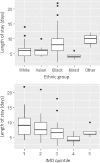Post-COVID-19 paediatric inflammatory multisystem syndrome: association of ethnicity, key worker and socioeconomic status with risk and severity
- PMID: 33727312
- PMCID: PMC7977079
- DOI: 10.1136/archdischild-2020-320388
Post-COVID-19 paediatric inflammatory multisystem syndrome: association of ethnicity, key worker and socioeconomic status with risk and severity
Abstract
Objectives: Patients from ethnic minority groups and key workers are over-represented among adults hospitalised or dying from COVID-19. In this population-based retrospective cohort, we describe the association of ethnicity, socioeconomic and family key worker status with incidence and severity of Paediatric Inflammatory Multisystem Syndrome Temporally associated with SARS-CoV-2 (PIMS-TS).
Setting: Evelina London Children's Hospital (ELCH), the tertiary paediatric hospital for the South Thames Retrieval Service (STRS) region.
Participants: 70 children with PIMS-TS admitted 14 February 2020-2 June 2020.
Outcome measures: Incidence and crude ORs are presented, comparing ethnicity and socioeconomic status of our cohort and the catchment population, using census data and Index of Multiple Deprivation (IMD). Regression is used to estimate the association of ethnicity and IMD with admission duration and requirement for intensive care, inotropes and ventilation.
Results: Incidence was significantly higher in children from black (25.0 cases per 100 000 population), Asian (6.4/100 000) and other (17.8/100 000) ethnic groups, compared with 1.6/100 000 in white ethnic groups (ORs 15.7, 4.0 and 11.2, respectively). Incidence was higher in the three most deprived quintiles compared with the least deprived quintile (eg, 8.1/100 000 in quintile 1 vs 1.6/100 000 in quintile 5, OR 5.2). Proportions of families with key workers (50%) exceeded catchment proportions. Admission length of stay was 38% longer in children from black ethnic groups than white (95% CI 4% to 82%; median 8 days vs 6 days). 9/10 children requiring ventilation were from black ethnic groups.
Conclusions: Children in ethnic minority groups, living in more deprived areas and in key worker families are over-represented. Children in black ethnic groups had longer admissions; ethnicity may be associated with ventilation requirement.This project was registered with the ELCH audit and service evaluation team, ref. no 11186.
Keywords: adolescent health; cardiology; epidemiology; statistics; virology.
© Author(s) (or their employer(s)) 2021. Re-use permitted under CC BY-NC. No commercial re-use. See rights and permissions. Published by BMJ.
Conflict of interest statement
Competing interests: None declared.
Figures




References
-
- RCPCH . Guidance: paediatric multisystem inflammatory syndrome temporally associated with COVID-19. London: Royal College of Paediatrics and Child Health, 2020.
-
- CDC . Multisystem inflammatory syndrome in children (MIS-C) associated with coronavirus disease 2019 (COVID-19). Center for Disease Control and Prevention, 2020.
Publication types
MeSH terms
Supplementary concepts
LinkOut - more resources
Full Text Sources
Other Literature Sources
Medical
Miscellaneous
